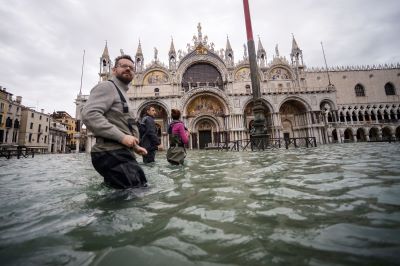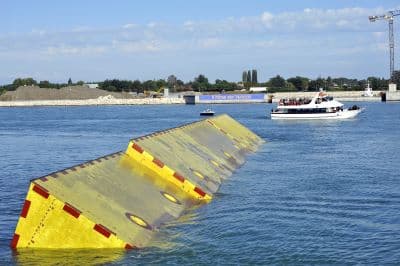The Italian city of Venice is a city that has captured the hearts of millions with its romantic canals, historic architecture, and unique way of life.
However, this enchanting city faces a grave and ongoing threat – it is sinking. The challenge of saving Venice from its relentless descent into the waters of the Adriatic Sea is one that has puzzled engineers, scientists, and policymakers for decades.
We will explore the complex issue of Venice’s sinking and the innovative engineering solutions that offer hope for its salvation.
The Subsidence Problem
In November 2019, Venice experienced its second-worst flooding; an event that gripped the attention of the world. Saint Mark’s Square, one of the most iconic areas, was covered in feet of water.
The high tide (also referred to as Acqua Alta) reached a peak height of 187cm (6.1ft) above sea level, and more than 80% of the city was underwater. A state of emergency was declared, and there was an estimated €1 billion (1.6 billion AUD) worth of damage, according to the Mayor of Venice, Luigi Brugnaro.
The first and most damaging flood in Venice happened in 1966 in which water levels rose to 194cm (6.4ft) above sea level, and seriously damaged at least three-quarters of the city’s shops, businesses, and studios.
Although 50 years separate these floods – experts, scientists, and engineers believe we won’t have to wait for another 50 to experience another.

According to a 2021 report, “Sea-level Rise in Venice: Historic and Future Trends”, even if global temperatures are kept below a 2C rise above pre-industrial levels, Venice’s sea level would rise by 32cm (13in) by 2100.
A worst-case scenario of a 4C temperature rise, linked to dramatic melting of the ice sheets, could see 180cm (5.9ft) of relative sea level rise in Venice by 2100 – like the level reached by the 2019 floods which caused so much damage.
Moreover, the city itself is sinking.
The foundations of Venice’s buildings are constructed using a system of piles, long pieces of timber that are pushed vertically into the loose mud and clay of the lagoon below. The solid bedrock of the lagoon is far further below the surface than this mud, so the foundations are being pushed into a more substantial, but still slightly vulnerable, layer of compressed clay.
Over centuries, many of the buildings built atop this unstable foundation have shifted position and, in numerous instances, started to sink into the mud.
Engineering Solutions for Venice
Engineers and scientists have been diligently working on solutions to address Venice’s sinking problem. While it is a challenging and ongoing endeavor, several innovative approaches offer hope for the city’s survival.
MOSE Project

The most ambitious and well-known project aimed at protecting Venice from flooding is the MOSE (Modulo Sperimentale Elettromeccanico) project, which is expected to be complete this year. MOSE consists of 78 mobile gates (barriers), each of which is 20 meters wide, at three inlets, namely Lido, Malamocco, and Chioggia, which will separate the Venetian Lagoon from the Adriatic Sea.
When tides rise to dangerous levels, these barriers will inflate with compressed air to block the entrance channels and prevent water from flooding the city.
Back in 2013, prior to the project’s commencement, €4.9 billion (8.1 billion AUD) was allocated to it. However, one year later, the budget had escalated to €5.3 billion (8.8 billion AUD). By November 2019, the project had reached a 94% completion milestone, and its expenses had surged to €5.5 billion (9.1 billion AUD), not factoring in prospective annual maintenance expenditures.
Land Reclamation
Land reclamation is an engineering strategy employed to address the challenges posed by subsidence and the growing needs of a city.
In this process, engineers work meticulously to create entirely new land areas adjacent to the lagoon. This endeavor involves depositing sediment and building up land from the seabed, effectively expanding the city’s territory.
One of the primary benefits of land reclamation is its ability to counteract subsidence, a common issue in coastal areas. By creating new land, engineers can stabilize the city’s foundation and reduce the risk of sinking.
Additionally, land reclamation offers a practical solution for urban expansion. As cities grow and populations increase, the demand for space intensifies. By reclaiming land from the sea, cities can accommodate new infrastructure, residential areas, and commercial developments without encroaching further into valuable natural landscapes or causing urban sprawl.
Reinforcing Foundations
Engineers are engaged in a critical mission to preserve the rich cultural heritage of Venice by strengthening the foundations of its historic buildings and structures.
This endeavor entails a sophisticated technique where they inject grout into the ground beneath these architectural treasures. This process serves a dual purpose: stabilization and elevation.
By injecting grout, engineers stabilize the ground beneath the historic edifices, reducing the risk of subsidence. Stabilizing the ground helps safeguard them from gradual sinking and structural damage.
Moreover, this technique also raises the buildings to their original positions or desired levels. Over time, due to various environmental factors, historic structures may settle or sink. By lifting them back to their intended heights, engineers not only restore their aesthetic integrity but also further protect them from potential flood-related damage in Venice’s unique aquatic environment.
Sustainable Tourism
In response to the challenges posed by tourism, Venice has undertaken a series of proactive measures aimed at mitigating its impact.
These strategies encompass the reduction of cruise ship arrivals and the promotion of sustainable tourism practices, all with the goal of alleviating the ecological strain placed on Venice.
By carefully managing the number of cruise ships that dock in Venice, the city seeks to reduce the environmental pressures associated with mass tourism. This includes minimizing issues like pollution, overcrowding, and potential damage to the ecosystem of the lagoon.
Additionally, Venice is actively promoting sustainable tourism practices. This entails encouraging responsible travel behaviors among visitors, such as waste reduction, energy conservation, and respect for the city’s cultural and environmental heritage.
By fostering an ethos of sustainability, Venice aims to ensure that tourism contributes positively to the city’s well-being while preserving its unique charm.
Challenges and Controversies
Despite these engineering efforts, Venice still faces significant challenges in its battle against sinking.
The MOSE project, which began in 2003, has been mired in delays, cost overruns, and controversies. Critics argue that the barriers may not be enough to safeguard the city against rising sea levels caused by climate change.
Additionally, some believe that these measures merely address the symptoms of Venice’s problems rather than the root causes.
Furthermore, engineering solutions alone cannot completely save Venice. Combating subsidence requires long-term strategies that involve careful monitoring, responsible groundwater management, and sustainable urban planning.
Effective and ongoing monitoring is a cornerstone of subsidence mitigation. By continuously assessing ground levels and identifying areas prone to sinking, authorities can intervene promptly to prevent or mitigate damage.
This proactive approach ensures that the city remains vigilant against subsidence’s long-term effects.
The fate of Venice hangs in the balance, and while engineering solutions are crucial components of the city’s survival plan, they must be integrated with broader strategies that address the complex web of factors that are contributing to its sinking.
Saving Venice is not just about saving a city; it’s about preserving a unique cultural and historical treasure.
Engineers, scientists, policymakers, and residents must continue to work together to find sustainable and effective solutions.
The world is watching, hoping that the city of Venice will endure for generations to come.


